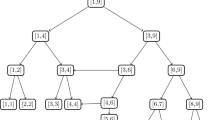Abstract
The inevitably poor utilization of storage by computed-access realizations of extendible rectangular arrays can be circumvented by storing such arrays by hashing. This paper studies the extent to which the same switch in storage strategy avoids the even worse utilization of storage by computed-access realizations of extendible ragged (i.e., nonrectangular) arrays. Unfortunately, the dramatic successes of the rectangular case do not carry over: any hashing scheme for extendible ragged arrays with storage demands very much smaller than those of computed-access realizations must suffer expected access time that is close to worst possible. On the other hand, one can obtain moderate savings in storage demands by hashing ragged arrays, together with sufferable access time. This last result issues from a general technique for trading increased access time for savings in storage. Even more striking savings are attainable if one restricts attention tofully-justified ragged arrays, whose raggedness is more regular than that of general ragged arrays. However, the overall impact of our results is that extendible ragged arrays do not succumb to the storage strategies that work efficiently on their rectangular counterparts.
Similar content being viewed by others
References
P. Chowla, On some polynomials which represent every natural number exactly once,Det Kongelige Norske Videnskabers Selskabs Forhandliger 34 (1961) 512–513.
E. D. S. de Villiers andL. B. Wilson, Hash coding methods for sparse matrices, Tech. Rpt. 45, Computing Lab., Univ. of Newcastle-upon-Tyne, 1973; see also: Hashing the subscripts of a sparse matrix,BIT,14 (1974) 347–358.
D. E. Knuth,The Art of Computer Programming I: Fundamental Algorithms, Addison-Wesley, Reading, Mass., 1968.
D. E. Knuth,The Art of Computer Programming III: Sorting and Searching, Addison-Wesley, Reading, Mass., 1973.
D. J. Rose andR. A. Willoughby, eds.Sparse Matrices and Their Applications, Plenum Press, New York, 1972.
A. L. Rosenberg, Computed access in ragged arrays, inInformation Processing 74 (J. Rosenfeld, ed.) North-Holland, Amsterdam, 1974, 642–646.
A. L. Rosenberg, Allocating storage for extendible arrays,Journ. ACM 21 (1974) 652–670.
A. L. Rosenberg, Managing storage for extendible arrays.SIAM J. Comput. 4 (1975) 287–306.
A. L. Rosenberg andL. J. Stockmeyer, Hashing schemes for extendible arrays,Journ. ACM, to appear.
Author information
Authors and Affiliations
Rights and permissions
About this article
Cite this article
Rosenberg, A.L. On storing ragged arrays by hashing. Math. Systems Theory 10, 193–210 (1976). https://doi.org/10.1007/BF01683272
Received:
Revised:
Issue Date:
DOI: https://doi.org/10.1007/BF01683272




